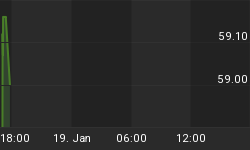Really need to start drinking more coffee, perhaps. Must have fallen asleep and missed the demise of the U.S. dollar. For when we looked this morning, it was still there trading away. Something must have happened while we were nodding off.
And then, must to our surprise, as we leaped from the bed and threw open the shutter, we discovered, that no, not the dollar, but the Euro was soon to vaporize. Abundant stories on the net clearly explained that not only was the Euro's disappearance imminent, but was also a necessity. Somehow destroying the currency representing one of the largest spheres of economic activity would help everyone involved. No wonder Keynesianism has been such an abject failure. They predict nothing that makes sense, and that which they do predict does not happen.

As the above chart portrays, rather than going to zero, the U.S. dollar has exited the inverted parabolic curve in which it had been trading. Exiting that formation the U.S. staged a nice healthy rally, as should have been expected.
Now, as the oscillator in the chart indicates, the U.S. dollar is over bought. It will need to correct that pattern, perhaps on the reality that no one is seriously pursuing Korean War II. Whatever the reasons might be, and we do propose two, the dollar is no longer in a short-term bear formation. That reality is being completely ignored by the precious metal markets.
Why might the U.S. dollar have ended the inverted parabolic formation?
First major reason likely relates to the U.S. election in early November. A structural break in the political continuum, much like the 1932 election, appears to have occurred. The Obama Regime's reign of financial terror has been ended by the voters. It will still do serious damage to the U.S. economy, but not to extent that would have been the case without the voter revolt. Frivolous gestures such as freezing federal wages to save a paltry $2 billion are not what U.S. voters had in mind. Fortunately, as the Obama Regime continues to ignore the voters, the likelihood of a one term presidency grows. That is surely bullish for the dollar.
Second, all, except intellectually inbred Keynesian economists, agree that the Federal Reserve's program of quantitative easing was and is an incredibly dumb idea. However, QE-1½, now being implemented, is the less dumb possibility. The current program is far less severe than the original idea of injecting a trillion dollars into the U.S. banking system. In short, the Federal Reserve could have done something far dumber, and that is good for the dollar.
In short, the big negatives that had pushed down the dollar are really not as negative as originally thought.

One global currency has not acknowledged the shift in currency thinking. $Gold, as portrayed in the above chart, has yet to break down out of the parabolic rise in which it has been trading. While the short-term picture shows some faltering, the consequences of this parabolic rise are like a sword hanging over our neck. So far so good, but the down stroke is yet to come. We have written considerably on the ramifications of a parabolic formation, and so will not do so again here.
Chart below moves us from the longer term view to the short-term battle in the $Gold market. As drawn in the chart, a head & shoulders pattern might be developing. Good news with this is that many of these formations fail to fully develop. However, the neck line is ~US$1,320, and move through that level could cause short-term traders to shed positions.
That all said, all need to recognize that what is happening in Gold and Silver as we write has noting to do with currencies, Korea, or any fundamentals. It is a full scale speculative trading environment. Buying in such an environment is the equivalent of hand feeding an alligator.

Given the above conditions, Investors should probably defer buying $Gold, and especially $Silver, until at least one of the following occurs.
One, the year-to-year percentage change for $Gold becomes negative.
Two, $Gold trades below US$1,000.
Three, we read of speculative hedge funds, which have helped to inflate the precious metals' bubbles, liquidating some positions.
While the long-term role of Gold as appropriate for inclusion in all portfolios has been reestablished in the past decade, short-term considerations should influence our buying. Therefore, with the second derivative on $Gold now negative, the short-term risk is far greater than the potential reward. Second derivatives are far more powerful than ideologies or fantasies of manipulation.
And for those playing in Silver, remember that playing is most apt description of current activity in Silver market. Keep in mind that a limit exists on the amount of capital losses that can be taken each year against ordinary income. Further, realize Silver is in a full-blown bubble/mania. Quite frankly, no reason exists for Silver to be trading as it is other than some mythical and delusional calculations that have been spread across the net. And do remember, micro economic environment for Silver has not been as favorable for Silver production as it is today in more than a "100 years."
GOLD THOUGHTS come from Ned W. Schmidt,CFA,CEBS as part of a joyous mission that has saved a multitude of investors from the financial abyss of paper assets. He is publisher of The Value View Gold Report, monthly, and Trading Thoughts, about weekly. To receive these reports, go to: www.valueviewgoldreport.com
















